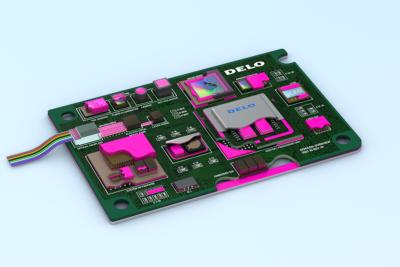We're happy to interview DELO, as part of our series of interviews with MicroLED Industry Association members. DELO is a leading maker of high-tech adhesives and other multifunctional materials as well as corresponding dispensing and curing equipment.
DELO's hightech materials come to play for numerous of semiconductor, automotive and consumer electronics applications
Can you introduce your company and technology?
Dr. Tim Cloppenborg, senior project manager: DELO is a leading manufacturer of high-tech adhesives and other multifunctional materials as well as adhesive dispensing and curing technology. Our products are mainly used in the automotive, consumer electronics, and semiconductor industries. They can be found in almost every mobile phone and in most cars worldwide, for example in cameras, loudspeakers, electric motors, or sensors. DELO's headquarters are in Windach, Germany, near Munich, with subsidiaries in China, Japan, Malaysia, Singapore, and USA, as well as representative offices and distributors in numerous other countries. We employ a workforce of 1,000 staff and achieved a turnover of almost €205 million in the last fiscal year. Our customers include Bosch, Huawei, Mercedes-Benz, Osram, Siemens, and Sony. As an innovative company, we always work ahead of the curve and pursue upcoming trends proactively. Regarding microLED applications, we are excited to provide adhesive research and expertise to our tech partners for the development of next generation displays, which will set a new standard for communication and visualization.
Can you say why you joined the microLED association and what it is you hope to achieve?
We joined the association to intensify the exchange with other network partner, to bring in our knowledge and to drive forward the microLED technology with our ideas and products. Thanks to our strong, global network, we can keep up with changing market conditions and subsequent customer requirements. Networks and associations are a great place for growing new ideas, inspiration, and collaborations.
Regarding microLED technology, our customers present us with complex bonding tasks. To meet these demands, we are glad to be member of the MIA network and share our knowledge with other outstanding technology-driven companies to provide cutting-edge solutions to this emerging market.
Moreover, at this crucial development stage of microLED technology, it is essential that the whole supply chain intensifies its collaboration with experts to pave the way for this extraordinary display technology.
What is your biggest challenge and success to date in the microLED industry?
The microLED industry needs to agree on standard procedures for processing and development. This will be one major step in the development of energy-efficient microLED-based devices. Currently, the developments are very customer-specific, and the general development roadmap is quite fuzzy. In this context, investments in equipment and further R&D are important for all MIA members to strengthen their abilities and expand their knowledge. At this stage, a lot of iteration steps are necessary to succeed in the R&D stage to then transfer to prototype stage. Nevertheless, we feel very positively about the latest developments in our adhesive portfolio and market feedback. Thus, we foresee major breakthroughs in the coming years.
Can you detail your latest prototype/demonstration?
For the development of adhesives and other multifunctional materials, we have to take into account various boundary conditions. For microLED technology, we identified various potential bonding tasks over the years. With respect to our product portfolio, we can offer materials for tailored transmission, transfer, die attach, conductivity and encapsulation. As mentioned before, it is not possible to say which of these will succeed and be qualified by our customers.
How do you see microLEDs changing the display industry in the next 5-10 years?
The display market has faced many challenges over the last few years in which LCD and OLED technologies drove the competition and steadily increased the entry barriers for microLED technology. Moreover, new form factors are being favored by next-generation customers who are digital natives. Within the next 5–10 years, microLED technology will overcome most of its current drawbacks and face a highly competitive market with the previously mentioned display technologies for several years. Nevertheless, the introduction of first-generation mass-production microLED devices will lead to their steep adoption in different markets which necessitate displays with low energy consumption and high resolution. These primarily range from automotive displays to XR devices and wearables, though most analysts agree wearables will be the earliest adopters due to their comparably smaller display size. A major question to be answered by the market is the tiling and binning of microLED displays to solve the current issue with cost intensive rework options during the mass manufacturing process.
We are looking forward to the bright future of microLED displays and are happy to be joining this development within the MIA Association, providing adhesives and other multifunctional materials to enable our partners to design outstanding devices.
